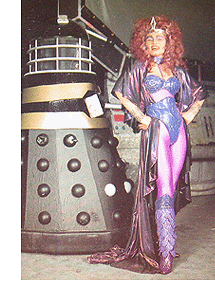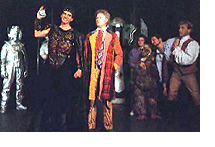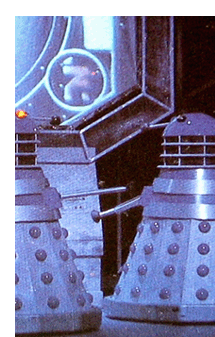| |
 The
Stageplay The
Stageplay
Introduction
In 1989 a Doctor Who Stage Play was mounted backed by TV
series producer of the time, John Nathan-Turner. Performances
began in the spring prior to what would be the final season of
the classic Doctor Who series and it opened in London on
23rd March.
The Ultimate Adventure was the third official Doctor
Who stageplay to be produced, after Curse of the Daleks
back in 1965 and The Seven Keys to Doomsday in 1974, the
latter of which was also written by Terrance Dicks, and all three
plays chose to exploit the obvious draw of the Daleks.
Broadly speaking Terrance Dicks' story was pitched for a younger
audience than the majority of television stories however it remained
true to the spirit of Doctor Who that its plot could be
followed easily by children, while the dialogue sustainted enough
jokes for the older members of the audience. The narrative took
the ambitious form of a string of set-pieces with special effects
and multiple locations that were realised with varying degrees
of detail.
There were three key elements that contributed to the lure of
this production: Firstly the lead was an actor who had actually
played the Doctor on television, something that had never happened
before. Secondly it featured both the Daleks and the Cybermen,
which was something of a fan's dream. Thirdly the production employed
lasers and a large computer screen to great visual effect giving
the play a technological edge and a portrayal of futuristic weapons
and force-fields that was superior to most of the television series.
 Aside
from the usual Doctor Who plot devices, The Ultimate
Adventure plagiarised two main elements from the television
series: The main thrust of the Daleks' plan was to cause war on
Earth by blowing up a peace conference after which each world
power would blame another for the bomb. With the Earth decimated
from its own conflict the Daleks would step in and quell the survivors.
This plot is identical to that of Day of the Daleks (1972).
Another strand copied once already on TV was the theft of a Dalek
casing by one of the heros. This idea was first seen The Daleks
(1963) written by Terry Nation and the Dalek creator reused his
own idea in his 1973 serial Planet of the Daleks. As if
that wasn't enough, on both television occasions and in The
Ultimate Adventure, the escapade culminated with the audience
believing the hero inside the Dalek had been killed when the Daleks
exterminated the imposter, only to discover the hero had already
climbed out unseen. Seeing this version of events on stage it's
hard not to wonder whether the glib nature of the explanation
was actually a deliberate reference to the previous repetition
of the idea. Aside
from the usual Doctor Who plot devices, The Ultimate
Adventure plagiarised two main elements from the television
series: The main thrust of the Daleks' plan was to cause war on
Earth by blowing up a peace conference after which each world
power would blame another for the bomb. With the Earth decimated
from its own conflict the Daleks would step in and quell the survivors.
This plot is identical to that of Day of the Daleks (1972).
Another strand copied once already on TV was the theft of a Dalek
casing by one of the heros. This idea was first seen The Daleks
(1963) written by Terry Nation and the Dalek creator reused his
own idea in his 1973 serial Planet of the Daleks. As if
that wasn't enough, on both television occasions and in The
Ultimate Adventure, the escapade culminated with the audience
believing the hero inside the Dalek had been killed when the Daleks
exterminated the imposter, only to discover the hero had already
climbed out unseen. Seeing this version of events on stage it's
hard not to wonder whether the glib nature of the explanation
was actually a deliberate reference to the previous repetition
of the idea.
 The
Cybermen were extremely under-used in the play, amounting to little
more than henchmen with only a few lines but the chance to pair
them up with the Daleks was an opportunity not to be missed. A
nice touch was the inclusion of the Dalek Emperor who was only
ever seen on screen in 1968's The
Evil of the Daleks, up until his re-invention for
the 2005 new series. Further continuity with the television series
came in the form of the Black Dalek who first appeared as head
of the Dalek invasion force in The Dalek Invasion of Earth
and as a general leader in the subsequent The Chase (1965)
and The Daleks Master Plan. The Dalek drones themselves
owed something in their appearance to the props in the first feature
flim, Dr Who and The Daleks in that they not only lacked
the shoulder slats of later stories but also posessed a blue and
grey colour sceme, including a blue head. Their colour scheme owed something to the Dalek movie props from the first film starred Peter Cushing entitled Dr Who and the Daleks. The grey and blue that appeared on stage, their tall stature, plus the fact that these props lacked their slats made them seem very reminiscent of their movie outing. The
Cybermen were extremely under-used in the play, amounting to little
more than henchmen with only a few lines but the chance to pair
them up with the Daleks was an opportunity not to be missed. A
nice touch was the inclusion of the Dalek Emperor who was only
ever seen on screen in 1968's The
Evil of the Daleks, up until his re-invention for
the 2005 new series. Further continuity with the television series
came in the form of the Black Dalek who first appeared as head
of the Dalek invasion force in The Dalek Invasion of Earth
and as a general leader in the subsequent The Chase (1965)
and The Daleks Master Plan. The Dalek drones themselves
owed something in their appearance to the props in the first feature
flim, Dr Who and The Daleks in that they not only lacked
the shoulder slats of later stories but also posessed a blue and
grey colour sceme, including a blue head. Their colour scheme owed something to the Dalek movie props from the first film starred Peter Cushing entitled Dr Who and the Daleks. The grey and blue that appeared on stage, their tall stature, plus the fact that these props lacked their slats made them seem very reminiscent of their movie outing.
Overall there was much to commend this production. It boasted
more alien settings than most television stories, a return of
one of the most popular actors to play The Doctor, plus two heavyweight
alien foes and an array of dazzling visual effects. Not a classic
work of fiction but a fondly-remembered 90-minute adventure.
Why not share your
recollections for inclusion on the website?
| |



